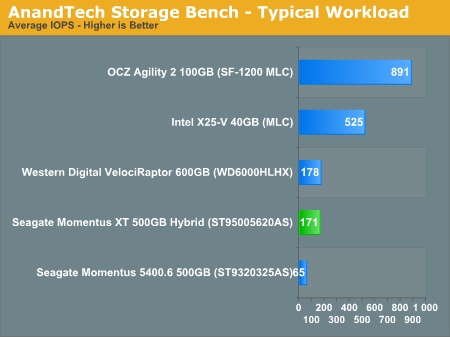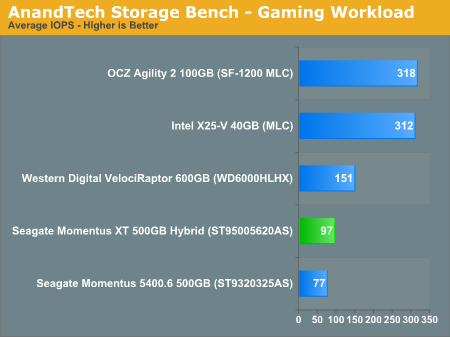Seagate's Momentus XT Reviewed, Finally a Good Hybrid HDD
by Anand Lal Shimpi on May 24, 2010 9:31 AM EST- Posted in
- Storage
- SSDs
- Seagate
- Momentus XT
- Hybrid Drive
- SSHDs
AnandTech Storage Bench
The first in our benchmark suite is a light usage case. The Windows 7 system is loaded with Firefox, Office 2007 and Adobe Reader among other applications. With Firefox we browse web pages like Facebook, AnandTech, Digg and other sites. Outlook is also running and we use it to check emails, create and send a message with a PDF attachment. Adobe Reader is used to view some PDFs. Excel 2007 is used to create a spreadsheet, graphs and save the document. The same goes for Word 2007. We open and step through a presentation in PowerPoint 2007 received as an email attachment before saving it to the desktop. Finally we watch a bit of a Firefly episode in Windows Media Player 11.
There’s some level of multitasking going on here but it’s not unreasonable by any means. Generally the application tasks proceed linearly, with the exception of things like web browsing which may happen in between one of the other tasks.
The recording is played back on all of our drives here today. Remember that we’re isolating disk performance, all we’re doing is playing back every single disk access that happened in that ~5 minute period of usage. The light workload is composed of 37,501 reads and 20,268 writes. Over 30% of the IOs are 4KB, 11% are 16KB, 22% are 32KB and approximately 13% are 64KB in size. Less than 30% of the operations are absolutely sequential in nature. Average queue depth is 6.09 IOs.
The performance results are reported in average I/O Operations per Second (IOPS):

Under typical multitasking workloads that aren't write intensive, the Momentus XT performs much like the new VelociRaptor. This isn't a typical notebook drive at all. We're still far away from even the cheapest SSDs though.
If there’s a light usage case there’s bound to be a heavy one. In this test we have Microsoft Security Essentials running in the background with real time virus scanning enabled. We also perform a quick scan in the middle of the test. Firefox, Outlook, Excel, Word and Powerpoint are all used the same as they were in the light test. We add Photoshop CS4 to the mix, opening a bunch of 12MP images, editing them, then saving them as highly compressed JPGs for web publishing. Windows 7’s picture viewer is used to view a bunch of pictures on the hard drive. We use 7-zip to create and extract .7z archives. Downloading is also prominently featured in our heavy test; we download large files from the Internet during portions of the benchmark, as well as use uTorrent to grab a couple of torrents. Some of the applications in use are installed during the benchmark, Windows updates are also installed. Towards the end of the test we launch World of Warcraft, play for a few minutes, then delete the folder. This test also takes into account all of the disk accesses that happen while the OS is booting.
The benchmark is 22 minutes long and it consists of 128,895 read operations and 72,411 write operations. Roughly 44% of all IOs were sequential. Approximately 30% of all accesses were 4KB in size, 12% were 16KB in size, 14% were 32KB and 20% were 64KB. Average queue depth was 3.59.

Crank up the sequential writes and you lose the benefit of the 4GB of SLC NAND on board the Momentus XT. It still delivers competitive performance with the X25-V thanks to the latter's limited write speeds, and it is faster than a conventional 2.5" drive as read operations still come off the NAND, but you don't get VelociRaptor performance out of it.
The gaming workload is made up of 75,206 read operations and only 4,592 write operations. Only 20% of the accesses are 4KB in size, nearly 40% are 64KB and 20% are 32KB. A whopping 69% of the IOs are sequential, meaning this is predominantly a sequential read benchmark. The average queue depth is 7.76 IOs.

As a benchmark that's bound by sequential read performance it's not surprising to see the Momentus XT not pull ahead here. Remember that we're limited by how quickly data can be streamed out of a single NAND device so you don't see a huge improvement in performance.










120 Comments
View All Comments
numberoneoppa - Monday, May 24, 2010 - link
As much as I miss my girlfriend who's been on the other side of the world for two weeks... I've missed you more, Anand.Welcome back.
SandmanWN - Monday, May 24, 2010 - link
That's just weird...Anand Lal Shimpi - Monday, May 24, 2010 - link
HAHA that's awesome. well, not for your girlfriend.Take care,
Anand
weakerthans4 - Monday, May 24, 2010 - link
There are some itches a girlfriend just can't scratch... Welcome back Anand!!!!quiksilvr - Wednesday, May 26, 2010 - link
Please stop saying things.falc0ne - Tuesday, July 6, 2010 - link
aaa..lol? :))DoktorSleepless - Monday, May 24, 2010 - link
Why wasn't a regular 7200 rpm drive used as another reference point? That would have been nice to have as well.Anand Lal Shimpi - Monday, May 24, 2010 - link
I mentioned this on the test page, I simply didn't have a modern 7200RPM 2.5" drive on hand (only older 7200RPM 2.5" drives which were slower than the 5400.6) while I was conducting these tests. As I put together the data for our HDD bench I will add them in though :)Between the 5400.6 and the WDVR you should be able to get a good idea of where this thing falls though.
Take care,
Anand
LoneWolf15 - Monday, May 24, 2010 - link
Yeah, the one thing though is that having, say, a normal Momentus 7200 would allow us to tell if the NAND is really offering us a benefit over a drive without it, and if so, what percentage performance increase can be attributed to it.I understand you didn't have the drive at this time, but if you could update this article in the future, it would be much appreciated.
pcfxer - Tuesday, May 25, 2010 - link
The issue with that line of thinking is that this drive is not just HDD+SSD, the algorithms that the drive uses to read and write data is on a vastly different ball field. This drive is an HDD with SSD capabilities and sometimes benefits.Until everyone understands that, they (consumers) will expect SSD performance at least some of the time, which is a result of poor understanding. Of course, after all the technical articles on SSDs and as a result HDDs, I'm amazed that people would ever expect any SSD performance from a HDD with flash. The flash is just like nitrous in a car; a 100 shot doesn't offer 100hp, but maybe 60hp instead. A good poke, but not the real thing.